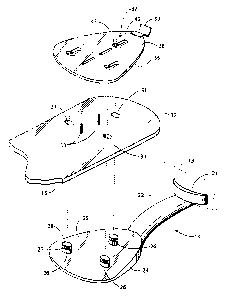Une partie des informations de ce site Web a été fournie par des sources externes. Le gouvernement du Canada n'assume aucune responsabilité concernant la précision, l'actualité ou la fiabilité des informations fournies par les sources externes. Les utilisateurs qui désirent employer cette information devraient consulter directement la source des informations. Le contenu fourni par les sources externes n'est pas assujetti aux exigences sur les langues officielles, la protection des renseignements personnels et l'accessibilité.
L'apparition de différences dans le texte et l'image des Revendications et de l'Abrégé dépend du moment auquel le document est publié. Les textes des Revendications et de l'Abrégé sont affichés :
| (12) Demande de brevet: | (11) CA 2465453 |
|---|---|
| (54) Titre français: | PALE DE VENTILATEUR DE PLAFOND A RACCORD RAPIDE |
| (54) Titre anglais: | QUICK CONNECT CEILING FAN BLADE |
| Statut: | Réputée abandonnée et au-delà du délai pour le rétablissement - en attente de la réponse à l’avis de communication rejetée |
| (51) Classification internationale des brevets (CIB): |
|
|---|---|
| (72) Inventeurs : |
|
| (73) Titulaires : |
|
| (71) Demandeurs : |
|
| (74) Agent: | FINLAYSON & SINGLEHURST |
| (74) Co-agent: | |
| (45) Délivré: | |
| (22) Date de dépôt: | 2004-04-28 |
| (41) Mise à la disponibilité du public: | 2004-11-01 |
| Licence disponible: | S.O. |
| Cédé au domaine public: | S.O. |
| (25) Langue des documents déposés: | Anglais |
| Traité de coopération en matière de brevets (PCT): | Non |
|---|
| (30) Données de priorité de la demande: | ||||||
|---|---|---|---|---|---|---|
|
A ceiling fan (10) is disclosed having a motor housing
(11) with an electric motor (13) to which is mounted an
annular array of blade irons (14) each having a blade
(15) and a locking plate (17) mounted thereto. Each blade
iron has three locking pins (26). Each locking pin has a
shaft (27) extending to a head (28). Each blade 15 has
three key-hole shaped locking pin mounting holes (31)
extending therethrough, a top surface (32) and a pair of
alignment pins (33) extending from the top surface. The
three locking pin mounting holes are configured and
oriented to receive the blade iron locking pins. Each
locking plate has a top surface (36), three locking pin
mounting holes (37), a pair of alignment pin slots (38) and
a thumb tab (39). The three locking pin mounting holes are
configured and oriented to receive and releasably lock with
the blade iron locking pins. With the locking pins
extending through the blade mounting holes and the locking
plate mounting holes the locking plate is pushed outboard
to its locked position preventing movement of the blade.
Note : Les revendications sont présentées dans la langue officielle dans laquelle elles ont été soumises.
Note : Les descriptions sont présentées dans la langue officielle dans laquelle elles ont été soumises.

2024-08-01 : Dans le cadre de la transition vers les Brevets de nouvelle génération (BNG), la base de données sur les brevets canadiens (BDBC) contient désormais un Historique d'événement plus détaillé, qui reproduit le Journal des événements de notre nouvelle solution interne.
Veuillez noter que les événements débutant par « Inactive : » se réfèrent à des événements qui ne sont plus utilisés dans notre nouvelle solution interne.
Pour une meilleure compréhension de l'état de la demande ou brevet qui figure sur cette page, la rubrique Mise en garde , et les descriptions de Brevet , Historique d'événement , Taxes périodiques et Historique des paiements devraient être consultées.
| Description | Date |
|---|---|
| Demande non rétablie avant l'échéance | 2010-04-28 |
| Le délai pour l'annulation est expiré | 2010-04-28 |
| Inactive : Abandon.-RE+surtaxe impayées-Corr envoyée | 2009-04-28 |
| Réputée abandonnée - omission de répondre à un avis sur les taxes pour le maintien en état | 2009-04-28 |
| Inactive : CIB de MCD | 2006-03-12 |
| Inactive : CIB de MCD | 2006-03-12 |
| Demande publiée (accessible au public) | 2004-11-01 |
| Inactive : Page couverture publiée | 2004-10-31 |
| Inactive : CIB attribuée | 2004-10-20 |
| Inactive : CIB en 1re position | 2004-10-20 |
| Demande reçue - nationale ordinaire | 2004-05-31 |
| Exigences de dépôt - jugé conforme | 2004-05-31 |
| Lettre envoyée | 2004-05-31 |
| Inactive : Certificat de dépôt - Sans RE (Anglais) | 2004-05-31 |
| Date d'abandonnement | Raison | Date de rétablissement |
|---|---|---|
| 2009-04-28 |
Le dernier paiement a été reçu le 2008-04-09
Avis : Si le paiement en totalité n'a pas été reçu au plus tard à la date indiquée, une taxe supplémentaire peut être imposée, soit une des taxes suivantes :
Veuillez vous référer à la page web des taxes sur les brevets de l'OPIC pour voir tous les montants actuels des taxes.
| Type de taxes | Anniversaire | Échéance | Date payée |
|---|---|---|---|
| Enregistrement d'un document | 2004-04-28 | ||
| Taxe pour le dépôt - générale | 2004-04-28 | ||
| TM (demande, 2e anniv.) - générale | 02 | 2006-04-28 | 2006-03-14 |
| TM (demande, 3e anniv.) - générale | 03 | 2007-04-30 | 2007-04-19 |
| TM (demande, 4e anniv.) - générale | 04 | 2008-04-28 | 2008-04-09 |
Les titulaires actuels et antérieures au dossier sont affichés en ordre alphabétique.
| Titulaires actuels au dossier |
|---|
| HUNTER FAN COMPANY |
| Titulaires antérieures au dossier |
|---|
| GREGORY MICHAEL BIRD |
| MASAO TSUJI |